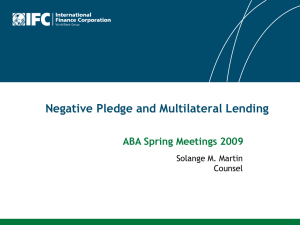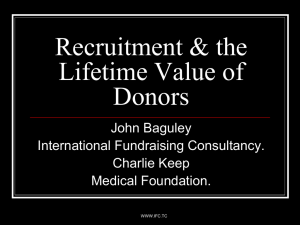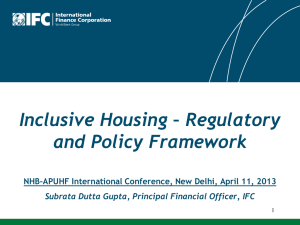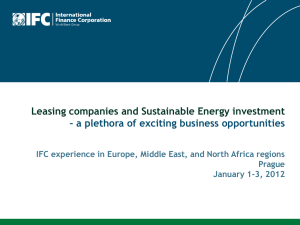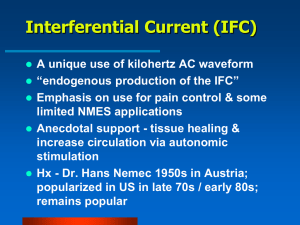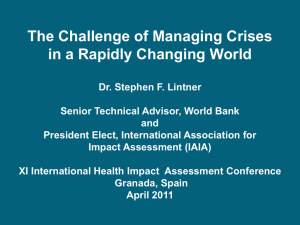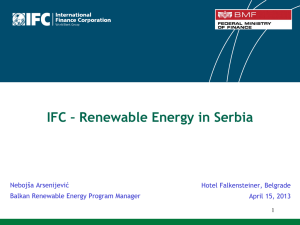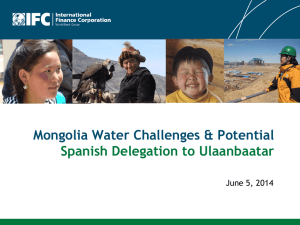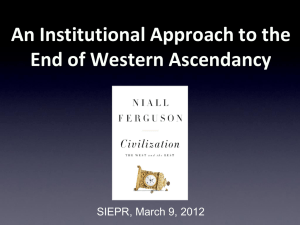Dr. Afifa Raihana - Climate Action Network South Asia
advertisement
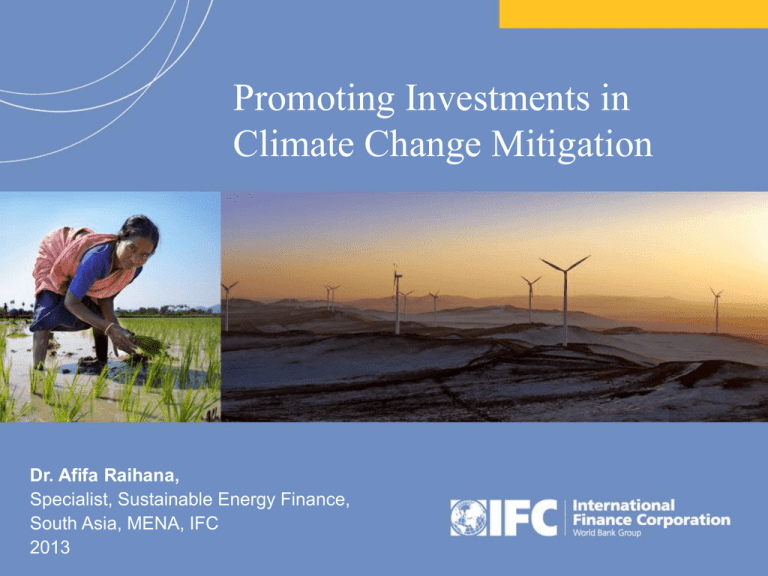
Promoting Investments in Climate Change Mitigation Dr. Afifa Raihana, Specialist, Sustainable Energy Finance, South Asia, MENA, IFC 2013 Climate Change undercuts development 25+% crop productivity drop in many countries by 20801 30% hunger risk increase by 20802 5 million 200 million illnesses due to climate permanently displaced ‘climate refugees’ by 20503 change in 20124 44 million people driven into poverty from rising food prices in 20105 4% GDP losses in Thailand from flooding in 20116 Sources: 1. William Cline “Global Warming and Agriculture” 2. World Development Report 2010 3. Columbia University CIESIN: “Environmentally Induced Population Displacements” 4. Journal Nature: “Impact of regional climate change on human health” 5. McKinsey: “Resource Revolution” 6. Bloomberg: “Thailand Says GDP May Shrink 3.7% on Floods” 2 IFC’s Climate Goals and Commitments IFC’s annual climate-smart investment targets: 1 Long term finance Short term finance 20% of long-term finance & 10% of trade finance by FY15 20% 13% 10% $3.3bn 6% $1.6bn FY12 2x FY15 2 IDG 6 – IFC Developmental Goal: GHG reduction in metric tons of carbon dioxide equivalent (tCO2e) 3 IFC tracks the gross GHG emissions of all real sector investments 3 Sustainability and Climate Change Sustainability covers more than climate change – Biodiversity, pollution prevention etc Climate Change – Energy (CO2) Energy efficiency (reducing consumption of energy) • Industrial • Housing and construction • Municipal Renewable energy (increasing non GHG production of energy) • Small • Off-grid/grid connected – Methane (CH4) avoidance (Agri, food processing, municipal waste and waste water) – Industrial gases (HF6, HFC’s, N20 etc) – Avoided Deforestation/Afforestation (capturing CO2) – Carbon Finance : an additional revenue stream for the above (a potential source for risk capital and incentives) Requires subsidy Area of Focus Area of Focus Fully Commercial IFC Approach Sustainable Energy Finance Fully commercial activities (Commercial banks) Commercial banks and DFIs Not fully commercial: Blended Finance Gap: In need of temporary subsidy Not fully commercial Gap: In need of LT subsidy Lack of commercial viability because of perceived/real risks, or costs but Where risk/reward balance for private sector can be achieved over time Blended Finance to private sector can “fill the gap” in the market and catalyze investments Permanent Subsidy (Government/NGOs) Approach being piloted for Agribusiness, Climate Change and SMEs 5 What is "Concessional Finance”? Financing at softer terms through price, tenor, rank, security or a combination to de-risk project Grants Loans with performance bonuses Early stage equity at submarket price Concessional First-loss Guarantee; Senior Debt with subsidy Market –based Financing Blended Finance = Concessional Finance + IFC Investment 6 Purpose of Concessional Funds: Low Risk High to catalyze investments that would otherwise not happen and which are just beyond commercial viability High Return Low 7 More than $300M Concessional Funds Available for Climate Change Projects Canada Climate Change Program (CCCP) • US$280M in-house • Eligible Projects: RE, EE, forestry, adaptation • Country Eligibility: IFC countries except China; in ECA only Moldova, Serbia, Georgia, Bosnia, Montenegro, Albania and Macedonia are eligible. • No equity or CDM • Max 30% subordinated • Local currency where possible Currently Available: ~$304 $140 M Climate Investment Funds (CIF) • Comprised of 4 funds • Mitigation (CTF) • Forestry (FIP) • Adaptation (PPCR) • Small RE (SREP) • Funds in house • ~$230 (CTF) •~$10 (SREP • ~$9 (PPCR) Global Environment Facility (GEF) • GEF/IFC Earth Fund ($40M) • Environmental Business Finance Program • Projects for SMEs through FIs ($24M) • Eligible Projects: RE, EE, biodiversity conservation • Available for countries with approved Investment Plans $143 M $31 M Delegated Authority from Donors 8 Concessional Finance in ASIA- Climate Change Projects 1 Project Project Size2 Donor Funds Concessional Finance Support Source of Funds Investment Transactions Techcombank (Vietnam) CGF 25 1 Credit line w/ performance bonus Earth Fund CHUEE SME (China) CGF 558 10 Guarantee/ First loss coverage EBFP Solar Power (Thailand) CIN 41 5 Credit line w/ concessional pricing CTF BMUL (Thailand) CGF 70 5 Guarantee/ First loss coverage CTF Credit line w/ concessional pricing CTF 3 La Suerte (Philippines) CIN 13 3 BPI SEF II (Philippines) CGF 70 3 Guarantee/ First loss coverage Earth Fund Dewan Housing (India) CGF 85 153 Credit line w/ concessional pricing Canada 862 42 Total Investment 1 Advisory Services Figures in $USD millions; 2 Committed Indonesia EE A2F 2 0.41 Advisory EBFP Vietnam CPEE A2F 2 0.90 Advisory CTF Philippines SEF A2F 2 0.80 Advisory CTF CHUEE 3 SME AS A2F 5 2.19 Advisory EBFP Biomass IPP C3P 2 0.45 Advisory Canada Thailand Clean Energy SBA 2 1.18 Advisory Canada/CTF 15 6 Total Advisory amounts by IFC, the donor and the FIs at programs’ inception 3 Approved, but not yet committed Market barriers for Scaling up Sustainable Energy Finance (SEF) • • • • High upfront costs High perceived risks Lack of proven business model Lack of capacity and information both at the FI level and also at the industry level • High technology cost • Lack of entrepreneurs • Lack of service providers What does IFC bring to the table? SBA Market transformation through technology demonstration, standards, and support to firms A2F (SEF) Wholesale model of climate financing through FIs Investment C3P IC Large transactions for bidding with public-private funding Regulation and Policy improvement IFC Approach: Scaling up Sustainable Energy Finance (SEF) IFC Value Proposition Enabling Partnerships to develop pipeline of new business: – Financial Institutions – Energy Service Companies (ESCOs) – Technology Manufacturers and Suppliers – Carbon off-takers Advisory services (donor-funded) to build client FIs capacity to identify and analyze these types of projects: – Market analysis and product development – Credit risk managers training Funding using financial products tailored to the needs of diverse markets: – Credit lines and senior loans – Risk sharing products and guarantees – Mezzanine financing and subordinated debt – Risk capital Promoting Clean Energy Promoting Clean Energy Projects Resource Efficiency Projects Resource Efficiency Projects Private Equity Funds related to Climate Change Fund Name Region Aloe 2 India Infuse Capital India N/A* 2013 Nereus Capital India N/A* 2013/14 GEF SACEF South Asia Aloe III East Asia and Pacific Total Commitment Description Committed Vintage ($) Capital ($) 28 million 2008 19.4 million Aloe 2 is a closed-end private equity fund which will make investments in companies in the clean energy sectors in Asia. 127 million 2010 N/A* 2013/14 5 million Indian Fund for Sustainable Energy (Infuse) is a fund established to invest in early stage companies engaged in wide array of products and services in the clean technology sector in India. It is housed within the Centre for Innovation Incubation and Entrepreneurship (CIIE), the business incubator at the Indian Institute of Management, Ahmedabad (IIMA). 20 million Nereus is a closed-end private equity fund formed to invest in companies engaged in the development, construction, or operation of renewable energy generation assets in India or the deployment of clean energy technologies in India. 18.5 million SACEF is a 10-year closed-end private equity fund dedicated to the clean energy sectors in the South Asia region. The Fund will make investments in energy efficiency, renewable energy generation, and environmental products and services. 25 million Aloe III is a closed-end private equity fund, which will make investments in companies whose business activities sustain, restore and improve the environment. Sectors of focus include, but not limited to, clean energy, waste recycling, and eco process. *Fundraising 18 PE Funds: Early observations Early Lessons Learnt • Lack of funds • • • • • • • • Difficulties for fund managers to raise capital Technology driven Resource for R&D largely missing Global financial crisis Sub sector diversification is required Appetite for risk will have to be greater than usual The early entrant premium will be present but diminishing Markets are still evolving brining opportunities and risks • Track records in isolation will remain a weaker indicator than in developed markets • Staying close to the market will be key • Constraint will be scaling up, not risk IFC Global Commitments IFC South Asia Climate Commitments Thank you! 23
